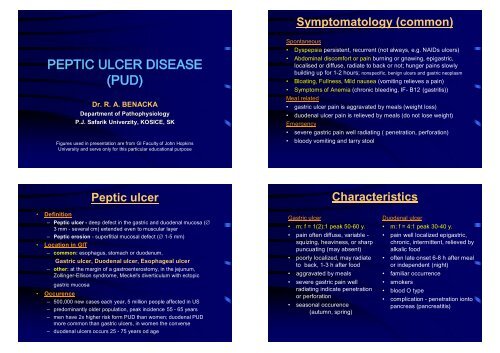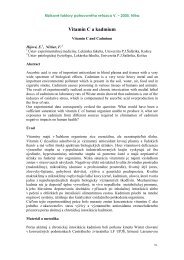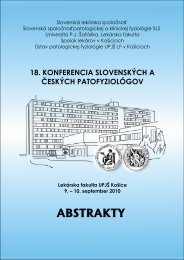Peptic Ulcer Disease - Diagnosis
Peptic Ulcer Disease - Diagnosis
Peptic Ulcer Disease - Diagnosis
Create successful ePaper yourself
Turn your PDF publications into a flip-book with our unique Google optimized e-Paper software.
PEPTIC ULCER DISEASE<br />
(PUD)<br />
• Definition<br />
Dr. R. A. BENACKA<br />
BE KA<br />
Department of Pathophysiology<br />
P.J. P.J.<br />
Saf afarik rik Univerzity, KOSICE KO ICE, , SK<br />
Figures used in presentation are from GI Facultyof John Hopkins<br />
University and serve only for this particular educational purpose<br />
<strong>Peptic</strong> ulcer<br />
– <strong>Peptic</strong> ulcer -deep defect in the gastric and duodenal mucosa (∅<br />
3 mm - severalcm) extended even to muscular layer<br />
– <strong>Peptic</strong> erosion -superfitial mucosal defect (∅1-5 mm)<br />
• Location in GIT<br />
– common: esophagus, stomach or duodenum,<br />
Gastric ulcer, Duodenal ulcer, Esophageal ulcer<br />
– other: at the margin of a gastroenterostomy, in the jejunum,<br />
Zollinger-Ellison syndrome, Meckel's diverticulum with ectopic<br />
gastric mucosa<br />
• Occurence<br />
– 500,000 new cases each year, 5 million people affected in US<br />
– predominantly older population, peak incidence 55 - 65 years<br />
– men have 2x higher risk form PUD than women; duodenal PUD<br />
more common than gastric ulcers, in women the converse<br />
– duodenal ulcers occurs 25 - 75 years od age<br />
Symptomatology (common)<br />
Spontaneous<br />
• Dyspepsia persistent, recurrent (not always, e.g. NAIDs ulcers)<br />
• Abdominal discomfort or pain burning or gnawing, epigastric,<br />
localised or diffuse, radiate to back or not; hunger pains slowly<br />
building up for 1-2 hours; nonspecific, benign ulcers and gastric neoplasm<br />
• Bloating, Fullness, Mild nausea (vomiting relieves a pain)<br />
• Symptoms of Anemia (chronic bleeding, IF- B12 (gastritis))<br />
Meal related<br />
• gastric ulcer pain is aggravated by meals (weight loss)<br />
• duodenal ulcer pain is relieved by meals (do not lose weight)<br />
Emergency<br />
• severe gastric pain well radiating ( penetration, perforation)<br />
• bloody vomiting and tarry stool<br />
Gastric ulcer<br />
• m: f = 1(2):1 peak 50-60 y.<br />
• pain often diffuse, variable -<br />
squizing, heaviness, or sharp<br />
puncuating (may absent)<br />
• poorly localized, may radiate<br />
to back, 1-3 h after food<br />
• aggravated by meals<br />
• severe gastric pain well<br />
radiating indicate penetration<br />
or perforation<br />
• seasonal occurence<br />
(autumn, spring)<br />
Characteristics<br />
Duodenal ulcer<br />
• m: f = 4:1 peak 30-40 y.<br />
• pain well localized epigastric,<br />
chronic, intermittent, relieved by<br />
alkalic food<br />
• often late onset 6-8 h after meal<br />
or independent (night)<br />
• familiar occurrence<br />
• smokers<br />
• blood O type<br />
• complication -penetration ionto<br />
pancreas (pancreatitis)
Etiopathogenetical<br />
considerations<br />
Gastro-duodenal physiology<br />
• Anatomy (stomach -antrum, body , fundus)<br />
• Components<br />
of gastric juice<br />
–Salts, Water<br />
–Hydrochloric acid<br />
–Pepsins<br />
–Intrinsic factor<br />
–Mucus<br />
• Components<br />
of duodenal juice<br />
– Enzymes<br />
(trypsin, chymotrypsin)<br />
– Water<br />
– HCO3-<br />
– Bile acids, bilines<br />
Regulation of digestive activity<br />
Saliva<br />
EGF<br />
VIP<br />
PHM<br />
HCl Gastrin Bombesin,<br />
GRP<br />
PEPSIN<br />
HCO3-<br />
N.Vagus<br />
Histamin<br />
Secretin<br />
GIP<br />
Somatostatin<br />
Motility Motilin pH 8<br />
Hydrochlorid acid production<br />
• Secreted by parietal cells<br />
• Stimulated by endogenous<br />
substances<br />
Gastrin I, II (G) -gastrin cells<br />
Acetylcholin (M1) - vagi<br />
Histamine (H2)<br />
Prostaglandins (E2, I2),<br />
Norepinephrin<br />
• Functions<br />
-converts pepsinogen into active<br />
pepsins<br />
-provide low pH important for<br />
protein breakdown<br />
-keeps stomach relatively free of<br />
microbes
(2) Mucosal protection<br />
• Gastric mucus -0,1-0,5 mm soluble vs. gel phase<br />
– mucin (MUC1, MUC2, MUC5AC, and MUC6 produced by<br />
collumnar epithelium<br />
– gel thicknessprostaglandins (PG E2) COX I inhibitors<br />
• Bicarbonate (HCO 3 - ) secretion<br />
– collumnar epitheliumin stomach, pancreaticjuice to duodenum<br />
– enters the solubleand gel mucus, buffers H + ions<br />
• Mucosal (epithelial) barrier<br />
– mechanical support aginst H+<br />
• Blood supply into mucose<br />
– removal of H + ions<br />
– supplywioth HCO 3 -<br />
Break through mucosal<br />
defence<br />
• First line defense (mucus/bicarbonate barrier)<br />
• Second line defense (epithelial cell mechanisms barrier<br />
function of apical plasma membrane)<br />
• Third line defense ( blod flow mediated removal of back<br />
diffused H+ and supply of energy)<br />
• First line repair -restitution<br />
if not working Epitelial cell injury<br />
• Second line repair -cell replication<br />
if not working Acute wound formation<br />
• Third line repair -wound healing<br />
if not working <strong>Ulcer</strong> formation<br />
Etiopathogenesis<br />
• Ballance betweenhostile and protective factors<br />
• ”No gastric acid, no peptic ulcer”- misconception<br />
Etiopathogenesis<br />
Agressive factors<br />
• Helicobacter pylori<br />
• Nonsteroidal Anti Inflammatory Drugs (NSAIDs)<br />
• Cushing ulcer (adrenocorticosteroids)<br />
• Hyperacidity (abnormalities in acid secretion)<br />
Protective factors<br />
• Curling ulcer (stress, gastric ischemia)<br />
• Abnormalities in gastric motility, duodenal-pyloric reflux,<br />
GERD<br />
• NSAIDs (abnormality in mucus production)
CAUSES<br />
Etiopathogenesis<br />
(1) Helicobacter pylori<br />
(1) Helicobacter pylori<br />
• Barry Marshall &Robin (1982)<br />
• Gram - curved rod, weakly virulent, likes<br />
acid enviroment, produces urease<br />
• acquired in children (10% - 80%), highest in<br />
developing countries (contaminated water ?)<br />
• Positive in > 90% of duodenal ulcer and<br />
>80% of gastric ulcer (maily diabetics)<br />
• Large percentage of people infected, but<br />
not all develop peptic ulcer<br />
Mechanisms:<br />
• Role in ulcer (or cancer)<br />
controversial -gastritis<br />
– leaking proof hypothesis<br />
– gastrin link hypothesis<br />
– ammonia production<br />
CAUSES<br />
Etiopathogenesis<br />
(1) Helicobacter pylori<br />
(2) NonsteroidalAnti InflammatoryDrugs<br />
(2) NSAIDs<br />
• Associated with < 5% of duodenal ulcer, ~ 25% of gastric ulcer<br />
• inhibition of cyclooxygenase-1 (COX-1)<br />
cyclo-oxygenase-1 - permanently expressed in cells<br />
cyclo-oxygenase-2 - inducibleinflammatory enzyme<br />
Prostaglandins<br />
• increase mucous and bicarbonate production,<br />
• inhibit stomach acid secretion,<br />
• increase blood flow within the stomach wall<br />
• Mechanisms:<br />
Local injury<br />
- direct (weak acids, back diffusion of H + )<br />
- inderect (reflux of bile containing metabolites)<br />
Systemic injury (predominant)<br />
-decreased synthesis of mucosal prostaglandins PGE2, PGI2<br />
NSAID users: incidence of H. pylori in patients with gastric ulcers <<br />
duodenal ulcers
NSAIDs -COX I inhibitors<br />
Class Examples<br />
acetylsalicylic acid aspirin<br />
diclofenac<br />
indomethacin<br />
ketorolac<br />
acetic acids<br />
nabumetone<br />
sulindac<br />
tolmetin<br />
meclofenamate<br />
fenamates<br />
mefenamic acid<br />
oxicams piroxicam<br />
ibuprofen<br />
ketoprofen<br />
propionic acids<br />
naproxen<br />
oxaprozin<br />
<strong>Ulcer</strong> Risk by Specific NSAIDs<br />
Lowest Risk Medium Risk (see note) Highest Risk<br />
Nabumetone (Relafen)<br />
Etodolac (Lodine)<br />
Salsalate<br />
Sulindac (Clinoril)<br />
CAUSES<br />
Aspirin<br />
Ibuprofen (Motrin, Advil, Nuprin,<br />
Rufen)<br />
Naproxen (Aleve, Naprosyn,<br />
Naprelan, Anaprox)<br />
Diclofenac (Voltaren)<br />
Tolm etin (Tolectin)<br />
Etiopathogenesis<br />
Flurbiprofen (Ansaid)<br />
Piroxicam (Feldene)<br />
Fenoprofen<br />
Indomethacin (Indocin)<br />
Meclofenamate (Meclomen)<br />
Oxaprozin<br />
Ketoprofen (Actron, Orudis KT<br />
(1) Helicobacter pylori<br />
(2) NonsteroidalAnti InflammatoryDrugs<br />
(3) Hyperacidity - Zollinger Ellison sy.<br />
(3) Hyperacidity<br />
• Gastrinoma (Zollinger-Ellison sy.) peptic ulcers (0.1% o fall<br />
cases) mainly in unusual locations (e.g. jejunum)<br />
– gastrin-producing islet cell tumor of the pancreas (gastrinoma)<br />
(50% ), duodenum (20%), stomach, peripancreatic lymph<br />
nodes, liver, ovary, or small-bowel mesentery (30%).<br />
– in 1/4 patients part of the multiple neoplasia syndrome type I<br />
(MEN I)<br />
– hypertrophy of the gastric mucosa, massive gastric acid<br />
hypersecretion<br />
– diarrhea (steatorrhea from acid inactivation of lipase)<br />
– gastroesophageal reflux (episodic in 75% of patients)<br />
• Hypercalcaemia (?)<br />
– i.v. calcium infusion in normal volunteers induces gastric acid<br />
hypersecretion. Calcium stimulates gastrin release from gastrinomas.<br />
– benefitial effect of parathyreoidectomy<br />
CAUSES<br />
Etiopathogenesis<br />
(1) Helicobacter pylori<br />
(2) NonsteroidalAnti InflammatoryDrugs<br />
(3) Hyperacidity - Zollinger Ellison sy.<br />
(4) Other factors
(4) Other<br />
Rarely, certain conditions may cause ulceration in the<br />
stomach or intestine, including:<br />
• radiation treatments,<br />
• bacterial or viral infections,<br />
• physical injury<br />
• burns (Curling ulcer)<br />
Etiopathogenesis<br />
SUSCEPTIBILITY FACTORS<br />
(1) Geneticfactors<br />
Genetic Factors<br />
Genetic predisposition for ulcer itself<br />
• Familiar agreggation of ulcer disease is modest<br />
in first-degree relatives3x greater incidency<br />
39% pure genetic factors; 61% individual factors (stress, smoking)<br />
Finnish twin cohort (13888 pairs)<br />
(Räihä et al.,Arch Intern Med., 158( 7), 1998)<br />
• 20–50% of duodenal ulcer patients report a positive family history;<br />
gastric ulcer patients also report clusters of family members who are<br />
likewise affected<br />
Genetic predisposition for H. pylori<br />
• Genetic influencesfor peptic ulcer are independent of genetic<br />
influences important for acquiring H pylori infection<br />
(Malaty et al., Arch Intern Med. 160, 2000)<br />
• increased incidence of H. Pylori caused ulcers in people with type O<br />
blood<br />
Etiopathogenesis<br />
SUSCEPTIBILITY FACTORS<br />
(1) Geneticfactors<br />
(2) Smoking
Smoking<br />
• correlation between cigarette smoking and complications,<br />
recurrences and difficultyto heal gastric and duodenal PUD<br />
• smokers are in about 2x risk to develop serious ulcer disease<br />
(complications) than nonsmokers<br />
• invovement of smoking itself in ulcer etiology „de novo“<br />
controversial (?) (? Stress associated with smoking)<br />
Mechanisms<br />
• smoking increases acid secretion, reduces prostaglandin and<br />
bicarbonate production and decreases mucosal blood flow<br />
• cigarette smoking promotes action of H. pylori(co-factors) in<br />
PUD<br />
Etiopathogenesis<br />
SUSCEPTIBILITY FACTORS<br />
(1) Geneticfactors<br />
(2) Smoking<br />
(3) Stress<br />
Animal studies<br />
Stress<br />
• inescapable stress - related ulcer (H. Selye)<br />
Human studies<br />
• social and psychologic factors play a contributoryrole in 30% to<br />
60% of peptic ulcer cases<br />
• conflicting conclusions ? (”ulcer-type” personality, A-type<br />
persons, cholerics, occupational factors -duodenal ulcer)<br />
• long-term adrenocorticoid treatment<br />
Background<br />
• stress-related acute sympathetic, catechlaminergic<br />
and adrenocortical response (GIT ischemia)<br />
• increases in basal acid secretion (duodenal ulcers)<br />
Etiopathogenesis<br />
SUSCEPTIBILITY FACTORS<br />
(1) Geneticfactors<br />
(2) Smoking<br />
(3) Stress<br />
(4) Coffee and acidic beverages<br />
(5) Chronic alcoholism
Other factors<br />
• COFFEE AND ACID BEVERAGES<br />
– Coffee (both caffeinated and decaffeinated), soft drinks, and<br />
fruit juices with citric acid induce increased stomach acid<br />
production<br />
– no studies have proven contribution to ulcers, however<br />
consuming more than three cups of coffee per day may<br />
increase susceptibilityto H. Pyloriinfection<br />
• ALCOHOL<br />
– mixed reports (somedata have shown that alcohol may<br />
actually protect against H. Pylori )<br />
– intensifies the risk of bleeding in those who also take<br />
NSAIDs<br />
Gastric ulcer<br />
Causes -conclusions<br />
• mucous permeability to H+<br />
• not necessary hyperacidity,<br />
even anacidity<br />
• gastrin (in hypoacidity)<br />
• delayed gastric emptying<br />
• duodeno-antral regurgitation<br />
• (bile acids)<br />
Lackof protectivefactors<br />
predominate<br />
Duodenal ulcer<br />
• number of parietal cells<br />
• gastrin onlyafter meat<br />
• HCO 3 - production<br />
• hyperacidity<br />
• rapid gastric emptying<br />
• neutralisation of acid<br />
• 80-90% H. pylori<br />
Predominanceof agressive<br />
factors<br />
<strong>Peptic</strong> <strong>Ulcer</strong> <strong>Disease</strong> -<strong>Diagnosis</strong><br />
(1) Radiological <strong>Diagnosis</strong><br />
• In use until 70’s: barium x-ray or upper GI series<br />
• 30% false results<br />
Prepyloric peptic ulcer Duodenal peptic ulcer<br />
<strong>Peptic</strong> <strong>Ulcer</strong> <strong>Disease</strong> -<strong>Diagnosis</strong><br />
(2) Laboratory <strong>Diagnosis</strong><br />
refractory (to 8 weeks of therapy) or recurrent disease<br />
• basal gastric acid output<br />
(?hypersecretion)<br />
• gastrin calcium<br />
(gastrinoma, MEN)<br />
• biopsies of gastric<br />
antrum (H. pylori)<br />
• serologic tests<br />
(H.pylori) IgG, IgA<br />
• urea breath tests<br />
(H.pylori)<br />
Lasts 20 minutes, highly sensitive
<strong>Peptic</strong> <strong>Ulcer</strong> <strong>Disease</strong> -<strong>Diagnosis</strong><br />
(3) Endoscopic <strong>Diagnosis</strong> -stomach<br />
• Observation<br />
• Biopsy &<br />
histology<br />
Today’s principal diagnostic method<br />
<strong>Peptic</strong> <strong>Ulcer</strong> <strong>Disease</strong> -<strong>Diagnosis</strong><br />
(3) Endoscopic <strong>Diagnosis</strong> -duodenum<br />
<strong>Peptic</strong> <strong>Ulcer</strong> <strong>Disease</strong> -Therapy<br />
• Medical therapy<br />
• Surgery<br />
• Endoscopic Therapy<br />
<strong>Peptic</strong> <strong>Ulcer</strong> <strong>Disease</strong> -Therapy<br />
(1) Medical therapy -principles<br />
1) reduce gastric acidity by mechanisms that inhibit<br />
or neutralize acid secretion,<br />
2) coat ulcer craters to prevent acid and pepsin from<br />
penetrating to the ulcer base,<br />
3) provide a prostaglandin analogs to maintain mucus<br />
4) remove environmental factors such as NSAIDs and<br />
smoking,<br />
5) reduce emotionalstress (if possible)
<strong>Peptic</strong> <strong>Ulcer</strong> <strong>Disease</strong> -Therapy<br />
Medical therapy -<br />
1) Antacids -largedoses required<br />
1 and 3 hours after meals,<br />
magnesium hydroxide -diarrhoea<br />
2) Histamine H2-receptor<br />
antagonists -cimetidine, ranitidine,<br />
famotidine and nizatidine<br />
3) Proton pump inhibitors -resistant<br />
to other therapies,prevent NSAIDgastroduodenal<br />
ulcers, omeprazole<br />
lansoprazole<br />
4) Prostaglabdin stimulators -<br />
Sucralfate, Misoprostol<br />
<strong>Peptic</strong> <strong>Ulcer</strong> <strong>Disease</strong> -Therapy<br />
Surgery<br />
•Vagotomy<br />
total<br />
selective<br />
super-selective<br />
1<br />
3<br />
2<br />
<strong>Peptic</strong> <strong>Ulcer</strong> <strong>Disease</strong> -Therapy<br />
Surgery BilrothI (antrectomy) + vagotomy<br />
<strong>Peptic</strong> <strong>Ulcer</strong> <strong>Disease</strong> -Therapy<br />
Surgery Pyloroplasty+ truncalvagotomy
• Hemorrhage<br />
• Perforation<br />
• Penetration<br />
Complications<br />
• Gastric outlet obstruction<br />
Haemorrhage<br />
• Most common, 5–20% of patients, duodenal> gastric ulcers,<br />
men > women, 75% stops spontaneously, 25% need surgery<br />
• Vomiting ofblood<br />
• Melena<br />
Haemorrhage (treatment)<br />
Laser coagulation<br />
Thermo- coagulation<br />
Electro- coagulation<br />
Sclerotherapy<br />
Perforation and penetration<br />
Perforation<br />
• 5–10% ulcers, in 15% die<br />
• peritonitis<br />
• gastric > duodenalulcers<br />
Penetration<br />
• 5-10% of perforating ulcers<br />
• pancreas, bile ducts, liver,<br />
small or large intestine<br />
70%
Gastric outlet obstruction<br />
• 5% ulcers, pyloric stenosis<br />
• inflammation, scarring<br />
• duodenal > gastric ulcer<br />
• endoscopic ditation<br />
• surgery<br />
Bilroth type 2<br />
Bilroth type 1




